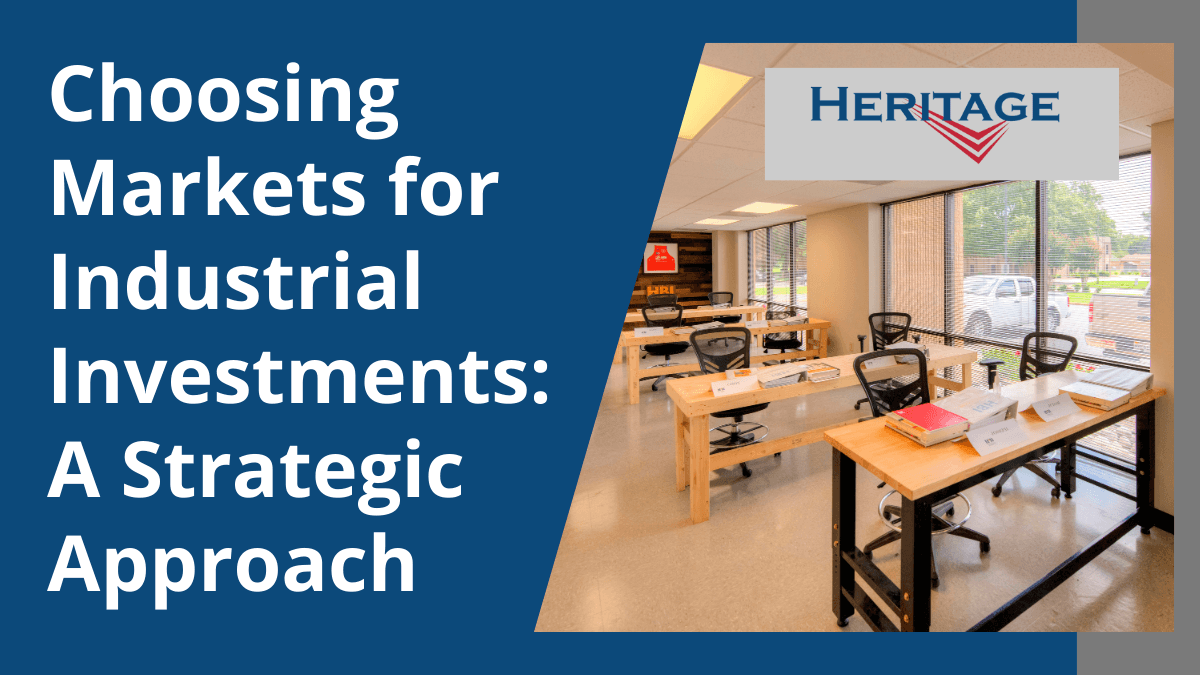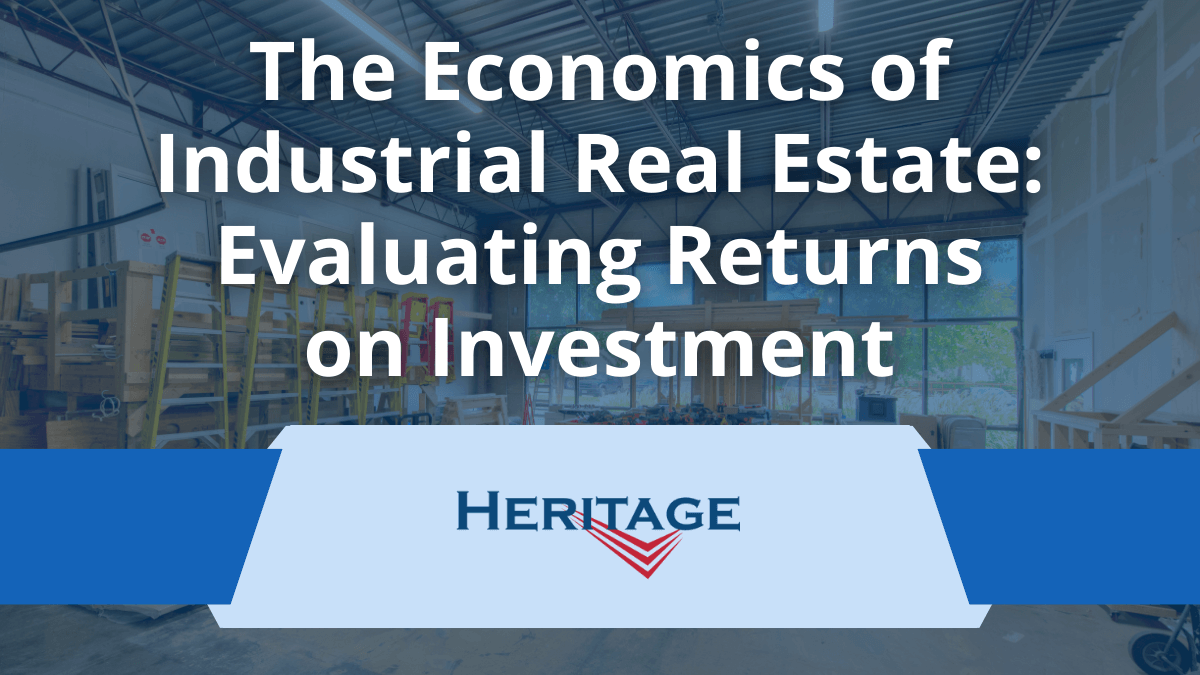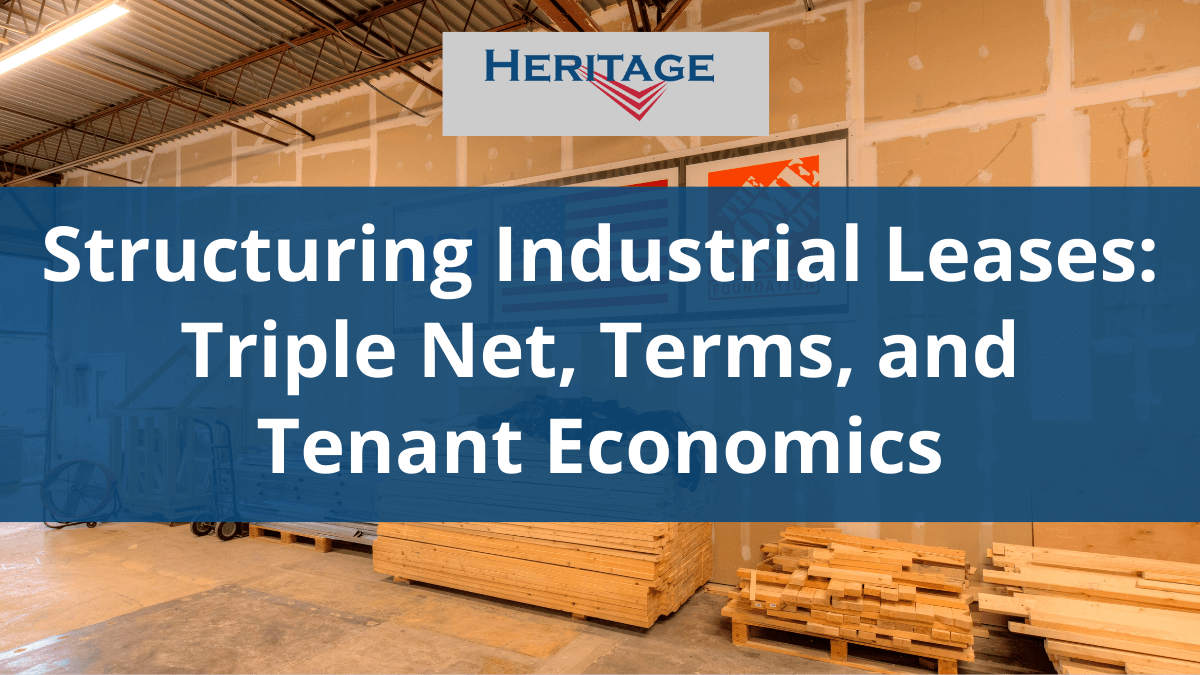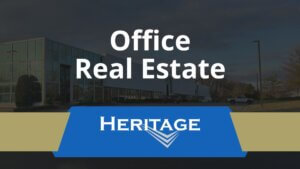As the industrial real estate sector continues to thrive amid the changing landscape of global commerce, the number of investors chasing industrial properties has skyrocketed. Many are first-time investors who have no prior experience or understanding of industrial real estate. While this sub-sector is not overly complicated, it does have its own nuances that must be considered for investors to be successful.
In this guide, we share Heritage Capital’s investment philosophy as it pertains to why, where, and how to invest in industrial real estate.
Our next investment is under contract. Please join the waitlist for priority access when the deal goes live.
Why Invest in Industrial Real Estate
Industrial real estate continues to be a valuable investment due to its resilience, driven by factors such as the growth of e-commerce, onshoring of manufacturing, and the adaptability of industrial properties. Here are some of the main reasons why we, at Heritage Capital, continue to be drawn to industrial property.

E-commerce growth is expected to continue.
Although industrial warehouse space was in high demand pre-pandemic, the explosion of e-commerce from 2020 through present day is unlike anything we have ever seen before. Retailers have found cost savings by closing (or minimizing) their storefronts and shifting more of their operations online. This has created a growing demand for industrial property, with rents moving all-time highs. We believe – and data supports – the idea that e-commerce will continue to grow, making industrial property a strong long-term prospect.
Manufacturing is onshoring for the first time in decades.
Another trend we are watching closely is the onshoring of manufacturing. For the last several decades, investors shied away from industrial real estate given the fear that all manufacturing companies would eventually end up in more cost-effective locations overseas. However, we like to say that it is never good to bet against America! Global unrest, supply chain complications, and rising transportation costs have made manufacturing here in the U.S. more compelling than ever. As onshoring of manufacturing picks up steam, we expect this to drive additional demand for industrial property.
Industrial properties are relatively simple and low maintenance.
The average industrial warehouse is simply a single story, large box that has been fit out with shelving systems, loading docks, and other basic equipment. These properties are much easier to build, own, and operate relative to other property types. Of course, there are some buildings that are more nuanced – cold storage and heavy manufacturing buildings are two examples – but in general, optimizing industrial buildings for tenant’s use is easier than fitting out other property types.
Moreover, many things can be done inside an industrial property. This is especially true among flex warehouse spaces. Whereas office spaces can only be used for office, and multifamily only for apartments, there is so much more than can be done inside industrial buildings. You can manufacture in these, distribute out of them, warehouse goods, have back office operations and more. Additionally, unlike other property types, industrial properties often have a net lease structure where the tenant pays the operating expenses of the property. Therefore, we believe these are truly flexible investments that have flexibility, efficiency, and upside opportunity.
Increased interest from institutional-caliber investors.
Industrial property is a sub-asset class within the commercial real estate industry.
The all-time high rents and low vacancy rates at industrial properties in recent years have strengthened the interest of institutional investors in these properties.
Some things simply cannot be done in the cloud.
The commercial real estate market has evolved in recent years, driven in large part by the growth of e-commerce discussed above and simultaneously, with more people able to work remotely. This has created a shift in the desirability of certain types of real estate.
To that end, we like to say that there are two things that you cannot do in the “cloud”: you can’t sleep in the cloud, and you cannot store stuff in the cloud. To us, that means that the only two types of real estate you want to own long-term are “heads in beds” real estate (e.g., multifamily and hotel properties) and industrial real estate, like manufacturing facilities, flex properties and warehouses where people can make and store their physical products and have some associated office space.

Where to Invest in Industrial Real Estate
For many businesses, especially those who no longer need traditional office space, how and where they do business has changed in recent years. Companies no longer need to own and operate their own warehouses, which has fueled demand for industrial warehouse in which businesses can lease portions of larger warehouse buildings.
Consider the local plumbing supply company that used to have its own warehouse to store their inventory. They no longer need to manage their own inventory; they can use a third party like Amazon who has its own managed services platform. That plumbing supply company no longer needs to store and ship their own inventory.
In short, industrial property has become fungible for many businesses. This means location, more than anything else, becomes the number one factor when evaluating where to invest in industrial real estate.
- Buying a “Good” Location.
Location, location, location is always key in real estate, regardless of the property type. However, it is especially important to industrial real estate. What makes a good location for industrial property? We typically look for access to roads, highways, and population centers. In the last few years access to labor has been a critical factor in tenant decisions. There are only so many opportunities to invest in properties that meet these criteria, so we evaluate each deal carefully based on its location and then determine whether it warrants further due diligence. Ultimately, while you may be able to build a new warehouse ten or 20 miles down the road, it is the buildings that have the best access and proximity to population centers that will outperform the rest
- Investing in Buildings with Heavy Power and Water Infrastructure.
One of the things that distinguishes industrial property from other asset classes is the need for significant power and water infrastructure. Cold storage and data centers, in particular, have intense electrical needs. In some markets, the electrical grid is simply insufficient for the needs of certain businesses. Access to water and sewer infrastructure is also important, particularly for heavy manufacturing and lab R&D buildings.
Understanding the power and water/sewer infrastructure is a key component of the due diligence process that we undertake here at Heritage Capital, as modifying or upgrading the capacity is often cost-prohibitive and can otherwise derail the investment.
- Renewed Focus on “Old” Manufacturing Towns.
Given the two items above – access to transportation and energy infrastructure, respectively – we have placed great emphasis on finding properties in often overlooked industrial areas. Many of these older industrial towns have properties at “cross-road” locations – places where two or more major roads or interstates meet. These well-located sites are often ideal warehouse and distribution hubs for those engaged in interstate commerce. The buildings are less expensive and investors are not building more of them; if they are, our buildings are worth more. Therefore, we are able to realize strong returns on a risk-adjusted basis.
For these reasons, we often avoid locations like big box warehouses in the outer-urban areas of cities like New York. Instead, we look for under-loved markets (Norfolk, Cincinnati, Indianapolis, Columbus, etc.) which we believe have strong risk adjusted returns and solid growth.
- Understanding the Alternative Uses for a Property.
When considering an industrial investment, we look not only at the tenant who is leasing the space today, but also what types of tenants could lease the space into the future. If the building is too customized, this could hinder leasing in the future. We want to understand the physical building – its size, ceiling heights, water/power infrastructure, loading docks, etc. – to understand if it could easily be repurposed for a range of other tenants in the future.
For example, we once owned a building where the ceilings were too low for most users. We ultimately converted the building for a kosher dairy company that needed 200,000 sq. ft. of refrigerated warehouse space and then sold it to them. We knew that this building would not lease well to other companies in need of traditional warehouse space, so once we found someone who it could work for, we sold it.
- Properties with “Sticky” Tenants.
Finally, we look at the “stickiness” of the tenants currently leasing a building when we explore acquisition. For example, we purchased one building in the middle of Indiana, which would not otherwise be an ideal location, but the tenant had 500 employees in this area – making it difficult for them to relocate elsewhere. The location is also only one hour from FedEx, Amazon, and UPS hubs which the company needed. These are some of the metrics we evaluate when evaluating potential investments.
How to Find Industrial Real Estate for Sale
While we have outlined the types of places where we like to invest, finding deals in these markets is no easy feat. At Heritage Capital, we take a holistic approach to sourcing deals that ranges from conducting our own market research to engaging with brokers in what we feel are up-and-coming markets. For example, we look at demographic trends; in markets where the population is growing, there will inherently be more demand for industrial real estate and goods will need to get to these people.
Many of our deals come through repeat relationships, however. Deals often find their way to us, as we have earned the reputation as reliable, sophisticated sponsors who are able to conduct thorough but streamlined due diligence processes and then move forward to closing.

Understanding Return Expectations with Industrial Property
One of the first questions investors will ask is about the returns we are targeting with any specific deal. The initial answer is always “as much as possible”! While we always strive to achieve the highest returns possible, in reality we are seeking strong risk adjusted returns.
What we are able to achieve depends on several factors, including macroeconomic conditions and current debt markets. In a rising interest rate environment like during the 2022-2023 period, that equates to at least high single digits or low double digit returns before accounting for financing. Not only do we have to cover our debt service and then some, but we are cognizant that investors often have other safer, more liquid investment alternatives. Therefore, we must be able to provide more compelling risk-adjusted returns at a spread above that.
- We invest diligently and patiently.In today’s society, where social media influencers are pushing the next “get rich quick” scheme, many investors have lost sight of investing diligently and patiently. At Heritage Capital, we believe in the old adage that says the best way to make money is to make money slowly. This is especially true when investing in real estate, where deals can take time to generate returns – but in our experience, this patience eventually pays off. Properties will continue to appreciate with time; rents will increase. We balance this by managing costs carefully in order to maximize value.Those looking for a “quick hit” generally will not find that when investing in industrial real estate. Of course, if an opportunity presents itself to make quick, short-term returns, we will explore those deals. However, the “quick hits” are rare and should be considered a bonus rather than the norm.
- What it means to “rent our money”. While we technically rent physical space to industrial tenants, what we are also doing is renting our money. When we evaluate properties, we consider what “rent” would be worthwhile on our money – is it a compelling investment? This framework considers not only your use of money, but how you grow that money and your investment portfolio over time. When we rent our money, we understand that our money is illiquid and there must be a premium rent factor that we return in exchange.
- Cap rate compression has become the norm in industrial real estate.The return expectations with industrial real estate have drastically changed over the last several decades. When we started investing in the early 90s, we were assuming loan costs at nine to 9.5 percent interest rates with cap rates that hovered around only 10 or 11 percent. This was before mass adoption of the Internet and certainly before the proliferation of e-commerce.
Fast forward to today, where the COVID pandemic has fueled demand for industrial warehouse space in nearly every region. Rents skyrocketed, driving industrial property values to new highs. In turn, cap rates plummeted. It is not uncommon to have well-located industrial properties trading at sub-4 percent cap rates in some markets. At Heritage Capital, we are careful not to get swept away in the hype. We do not purchase properties at 4 percent cap rates and instead, continue to uncover deals at 7 percent cap rates and above – even if it means we are finding deals in places like Indianapolis that are not on other investors’ radars.

Navigating Industrial Real Estate Leases
Industrial real estate tends to utilize one of two forms of leases: gross or net leases. Gross leases are when the tenant pays a flat, per square foot rent that includes all ancillary expenses including their pro rata share of taxes, insurance, and utilities. It can be thought of like a “full service” lease.
Net leases, meanwhile, utilize a base rent and then the tenant is responsible for paying their pro rata share of various expenses. Most industrial landlords will utilize Net leases. The base rent is lower but, in turn, the landlord foregoes any unexpected or rising costs associated with the property.
In our experience at Heritage Capital, either a gross or net lease can be profitable. Gross leases simply need to be structured in a way that sufficiently covers our costs. Generally, we will utilize either a gross or a net lease depending on the norm in that particular market. We can make either work to our advantage using appropriate forecasting, built-in rent escalations, and more.
- Shorter vs. Long-Term Leases.One of our differentiators, however, is that we are comfortable using short (e.g., 3- 5 year) leases. This contrasts with other industrial investors who generally prefer five- or 10+ year leases. Long-term leases with credit-worthy tenants have long been the industry’s gold standard, and today, this is what many banks will require before making a loan on a property. In our experience, it can cost more to sign a long-term lease than it does a short-term lease.In practice, just because someone signs a long-term lease, that does not guarantee they will stay in the space for the duration of their lease term. Many tenants will inevitably move. However, they have negotiated a lower lease rate in exchange for the long-term lease. Generally, they will have negotiated a higher tenant fit-out allowance as well given that they are signing a long-term lease. The fit-out cost on a five-year lease might be $5 per sq. ft. but could easily double to $10 per sq. ft. or more on a 10-year lease. This drives up both initial costs as well as broker commissions, as we pay higher commissions on longer-term leases. If the tenant eventually has to move – or worse, goes bankrupt – we will have invested significant dollars in that lease compared to the lighter lift and up-front costs associated with shorter-term leases.We have found that shorter term leases translate into us paying less and earning higher rent. It also makes the space more attractive to tenants who are only willing to sign a short-term lease, vs. some owners who will not entertain a lease term of less than five years.
- Evaluating Tenant Creditworthiness.Again, the industry’s gold standard is to find tenants with excellent credit and strong balance sheets. To be sure, Heritage Capital does ask prospective tenants to open their books and we conduct thorough due diligence on businesses before they sign leases – especially longer-term leases. Financial strength also comes with a cost; the more financially secure the tenant, the lower lease rate they will try to negotiate given their perceived “safety.” Some tenants will try to shield their credit from us as the landlord. They will have a single purpose entity as the tenant. We have learned, through our experience, to have the parent company guarantee the lease to ensure there is sufficient credit behind it.However, we also understand that unforeseen circumstances occasionally arise. For example, no matter how financially strong any given office tenant was pre-Covid, they might not have been able to sustain their lease during and post-pandemic. The value of office buildings has collapsed in many markets as a result. Even the most robust due diligence cannot guarantee that a tenant will survive black swan events like these.
- Getting to Know Your Tenants.One key to industrial leasing is getting to know your tenants and their businesses. At Heritage Capital, we invest time and resources in learning what makes these businesses tick. Why do they want to locate here? How can they grow their businesses? What can we do to support them?Our roster of tenants is incredibly diverse. One makes credit cards, one makes equipment for the Air Force, another manufactures carbon fiber steel beams. We also have a mochi manufacturer and a vitamin manufacturer, among others. Each of these businesses is vastly different, which highlights that industrial goes far beyond the typical Amazon warehouse (which we also have as a tenant) that people think of when they talk about industrial real estate. What makes each of these businesses successful differs, and we learn about their individual needs in order to help them grow and thrive – so ultimately, they stay and/or grow into more space within our properties.
No Education or Training Can Replace Experience
Navigating the nuances of each industrial building – and finding ways to optimize the property on behalf of our investment partners – is in our DNA. Our experience has given us knowledge that simply cannot be taught.
Conclusion
The industrial real estate market is ripe with opportunity. The unprecedented surge in e-commerce, the resurgence of onshoring, and the inherent flexibility of industrial properties underscore their enduring appeal. Heritage Capital's experience allows us to navigate this dynamic sector successfully.
As the industry continues to evolve and demand for manufacturing and warehouse spaces continues to grow, strategically investing in industrial real estate will prove to be an increasingly popular strategy among those who have a trusted, experienced partner by their side. We will continue to be that partner.



